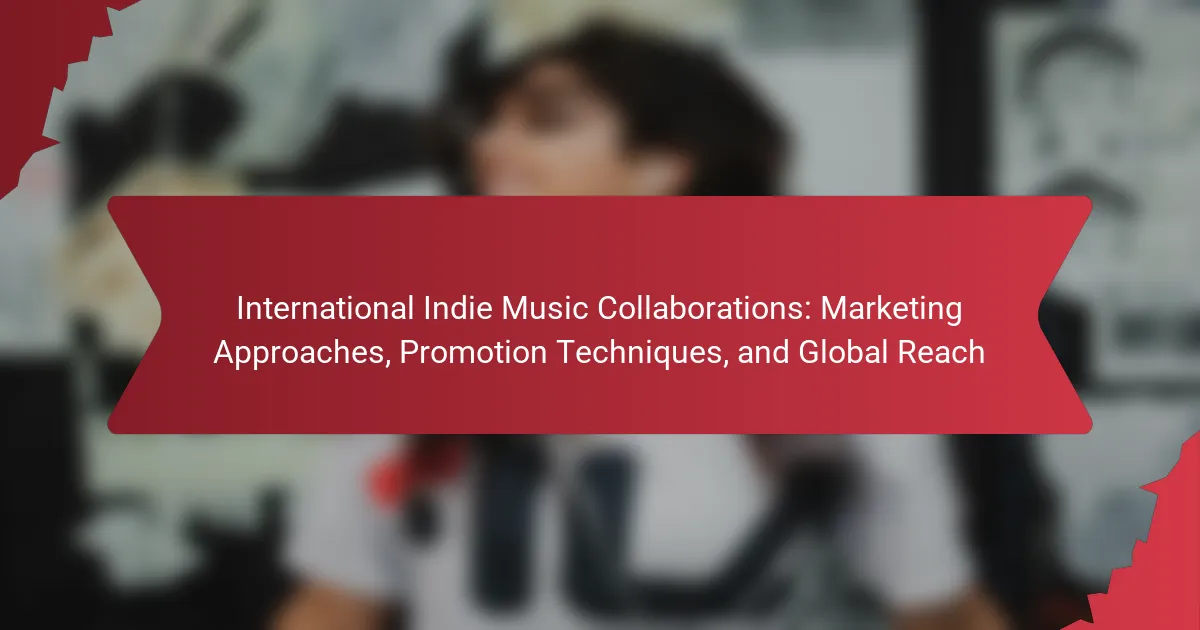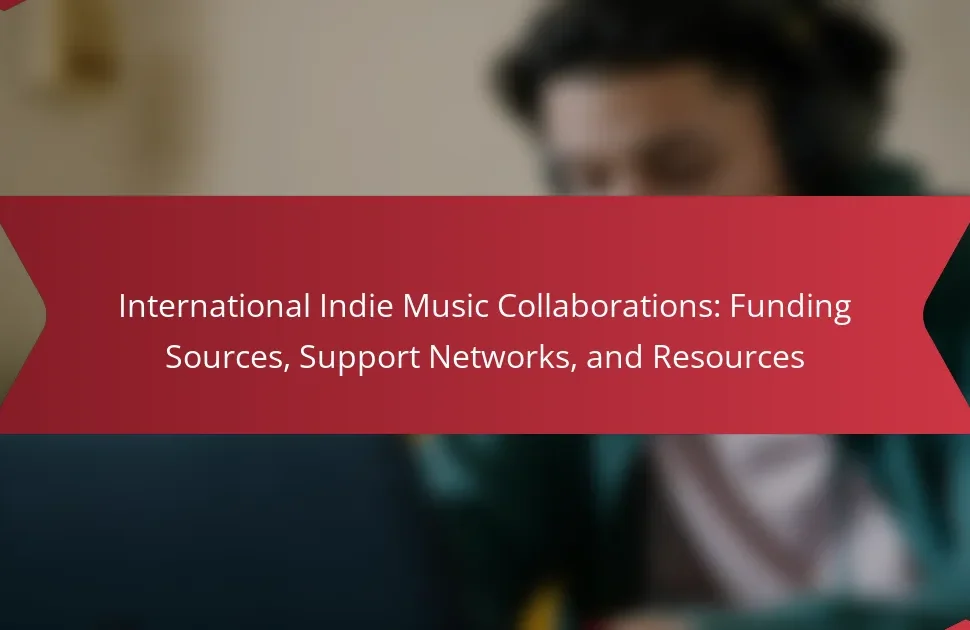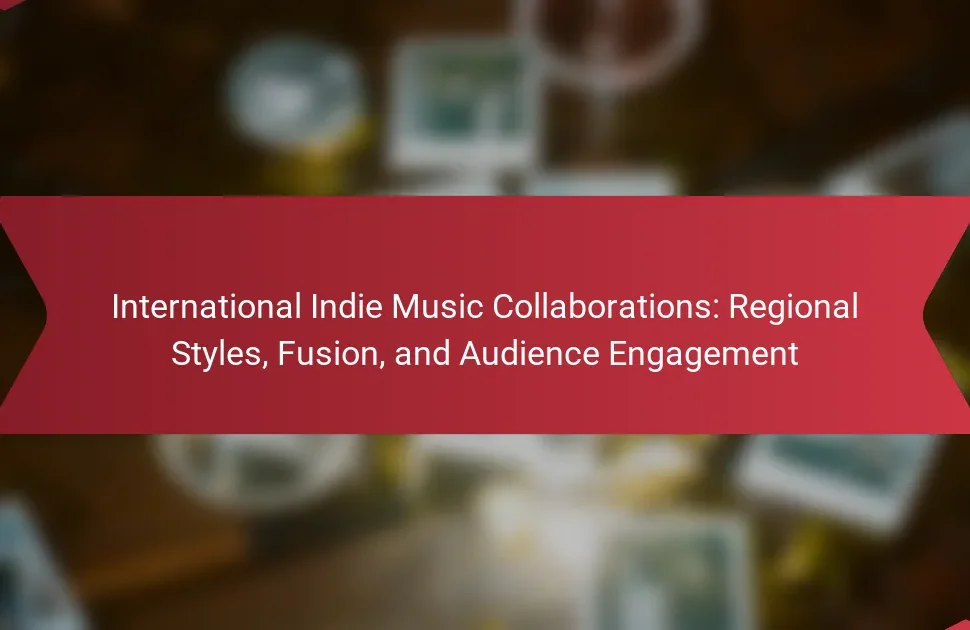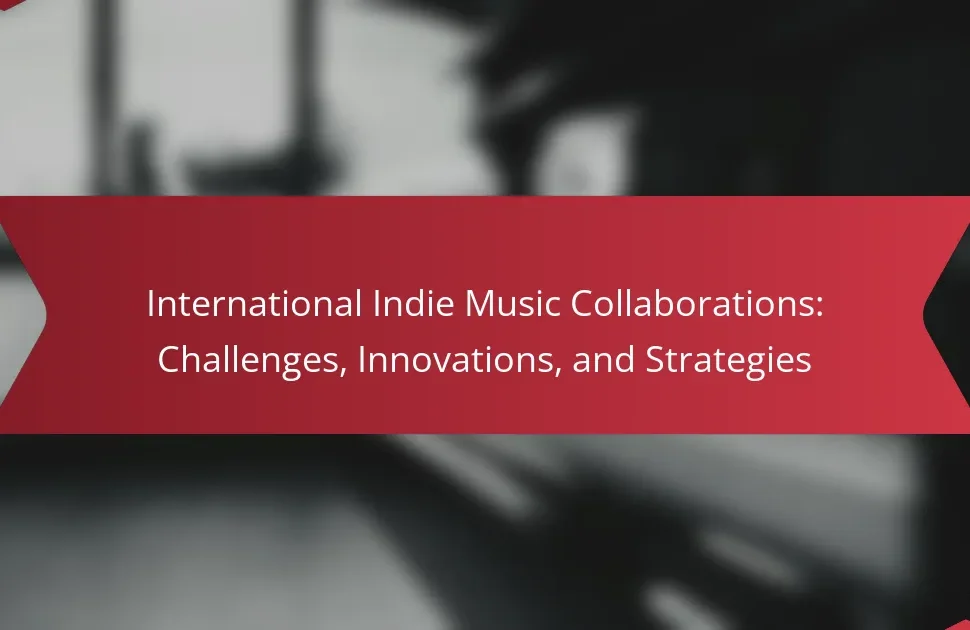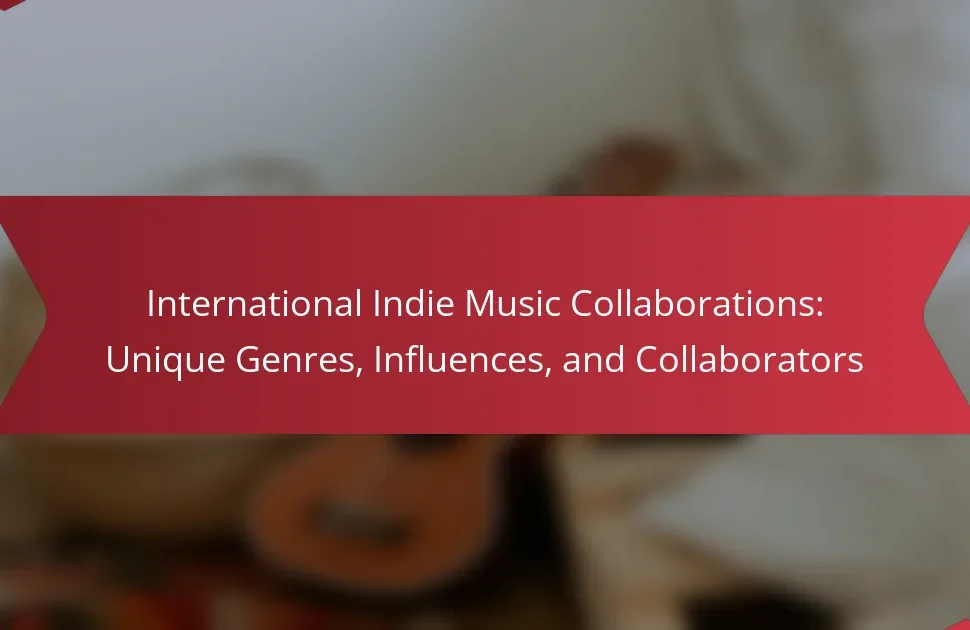International indie music collaborations can significantly expand an artist’s global reach. This article explores diverse marketing approaches, effective promotion techniques, and the importance of metrics in measuring success. Key strategies include leveraging social media platforms, engaging with influencers, and utilizing streaming services to enhance visibility. By understanding these elements, indie artists can effectively connect with international audiences and foster meaningful collaborations.
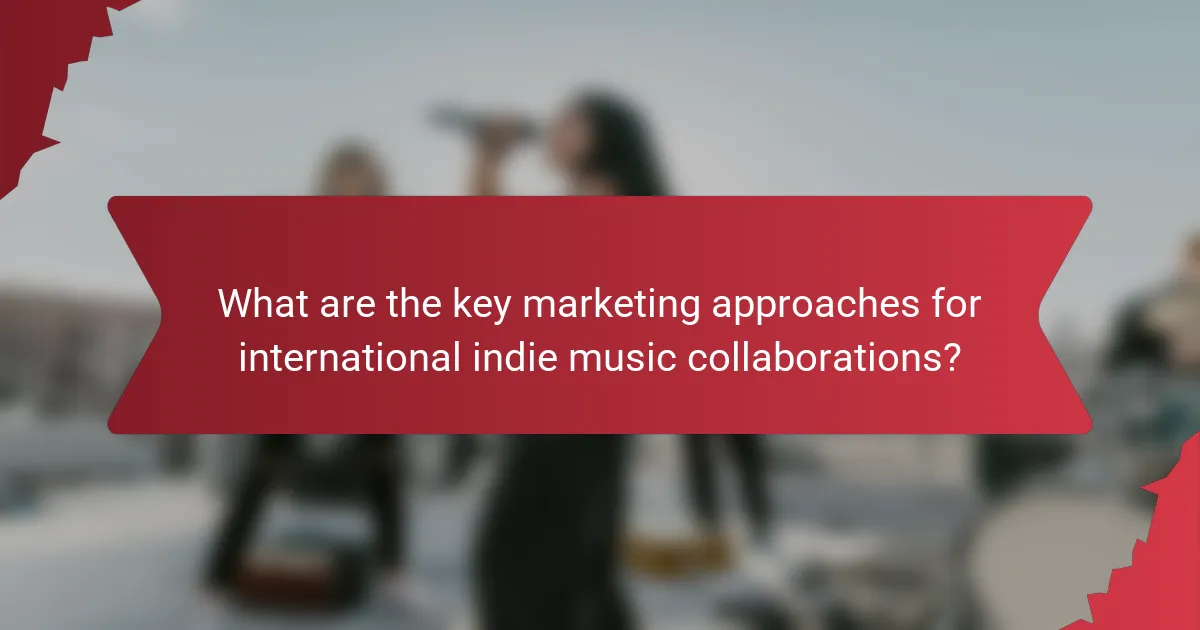
What are the key marketing approaches for international indie music collaborations?
International indie music collaborations can leverage diverse marketing approaches to enhance global reach. Key strategies include social media campaigns, influencer partnerships, and targeted online advertising.
Social media platforms like Instagram and TikTok allow artists to showcase their work and connect with international audiences. Collaborating with influencers can amplify reach and credibility, while targeted ads can effectively engage specific demographics.
Utilizing streaming platforms for promotional playlists increases visibility, while virtual events and live streams create interactive experiences. These techniques collectively foster a broader audience engagement and facilitate cross-border collaborations.
By integrating these marketing approaches, indie artists can maximize their impact in the competitive global music landscape.
How do cultural differences influence marketing strategies?
Cultural differences significantly shape marketing strategies for international indie music collaborations. Understanding local customs, values, and preferences allows marketers to tailor their approaches effectively.
For instance, in Asia, collaborations may emphasize community and harmony, influencing promotional content. In contrast, Western markets might prioritize individuality and self-expression, shaping messaging and branding strategies.
Additionally, language plays a crucial role in marketing. Localizing content not only improves engagement but also builds trust with audiences. Unique cultural references can enhance relatability, making campaigns more impactful.
Finally, cultural trends influence platforms used for promotion. For example, social media trends differ globally; while Instagram may dominate in some regions, others may prefer TikTok or local platforms. Adapting to these preferences is essential for maximizing global reach.
Which digital platforms are most effective for promotion?
Social media platforms, streaming services, and music blogs are effective for promoting international indie music collaborations.
Social media platforms like Instagram and TikTok enable artists to engage directly with fans. Streaming services such as Spotify and Apple Music provide global reach and playlist opportunities. Music blogs offer reviews and features that enhance visibility.
Utilizing targeted ads on these platforms can significantly increase audience engagement. Collaborations with influencers can also amplify reach and attract new listeners.
What role do social media influencers play in global reach?
Social media influencers enhance global reach for international indie music collaborations by leveraging their vast audiences. They create authentic connections that resonate with diverse demographics. Influencers promote music through engaging content, driving awareness and engagement across platforms. Their unique ability to bridge cultural gaps enables indie artists to access new markets, amplifying visibility and fostering collaboration opportunities.

What promotion techniques resonate with diverse audiences?
International indie music collaborations can effectively resonate with diverse audiences through targeted promotion techniques. Utilizing social media platforms enables artists to engage with global fans. Collaborating with local influencers enhances cultural relevance. Tailored marketing campaigns that reflect regional tastes attract wider participation. Engaging live performances and virtual events foster community connection.
How can collaborations leverage local music scenes for visibility?
Collaborations can significantly enhance visibility in local music scenes by tapping into established networks. Artists can leverage local influencers, venues, and audiences to amplify their reach. This approach builds community engagement and fosters authentic connections. Collaborations create opportunities for cross-promotion, where local acts introduce international artists to their fan base. Additionally, participating in local events allows for direct interaction with audiences, increasing exposure and generating buzz. By aligning with local music scenes, international indie collaborations can cultivate a loyal following and enhance their global presence.
What are the benefits of cross-promotion among artists?
Cross-promotion among artists enhances visibility, expands audiences, and fosters collaboration. It allows artists to leverage each other’s fan bases, increasing engagement and reach. For instance, joint releases or social media promotions can introduce artists to new listeners. This strategy can lead to unique creative opportunities, enhancing the artistic value of their work.
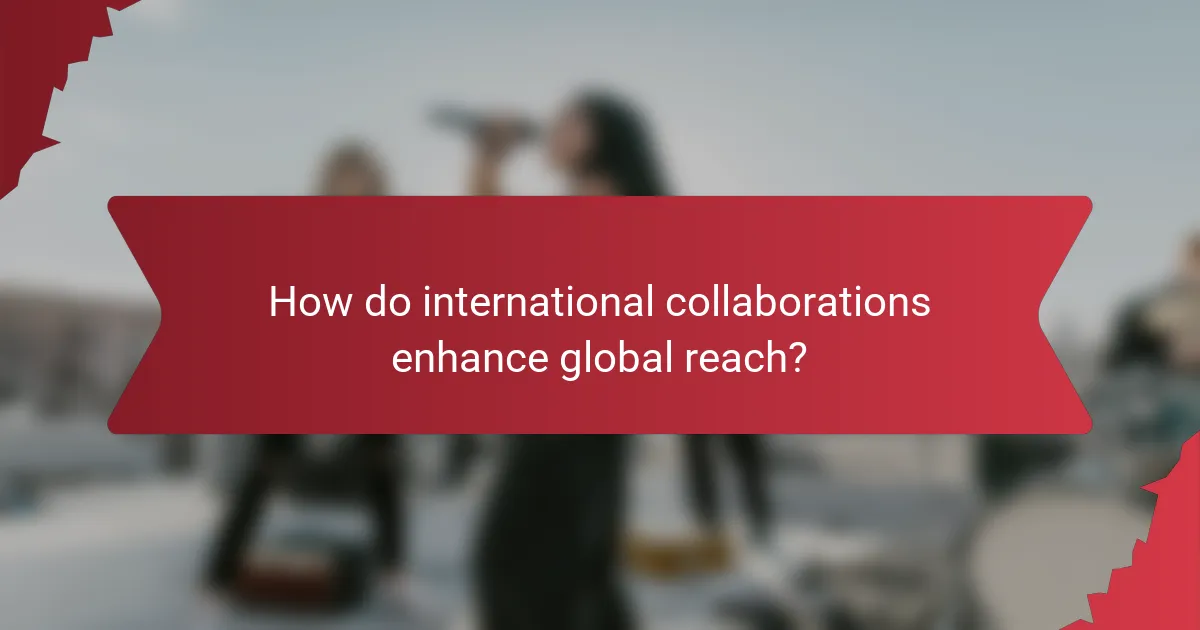
How do international collaborations enhance global reach?
International collaborations enhance global reach by expanding audience access and fostering diverse musical influences. Artists can leverage each other’s fan bases, resulting in increased visibility. Joint marketing strategies, such as cross-promotions and shared social media campaigns, amplify their collective impact. Collaborations also introduce unique sounds, attracting listeners from different cultures and regions. This fusion of styles can create a broader appeal, driving international streams and downloads. Ultimately, these partnerships cultivate a global community around indie music, enhancing its overall presence in the music industry.
What are the unique challenges faced in cross-border collaborations?
International indie music collaborations face unique challenges such as cultural differences, language barriers, and varying marketing strategies. These factors can complicate communication and audience engagement. Additionally, navigating different legal frameworks for copyright and distribution requires careful planning. Building trust and establishing relationships across borders is essential for successful collaboration.
How do time zones and scheduling affect collaboration efforts?
Time zones and scheduling significantly impact collaboration efforts in international indie music. Coordinating across different time zones can lead to delays, miscommunication, and reduced productivity.
Effective scheduling requires awareness of time differences and flexibility in meeting times. For example, using tools like shared calendars can help synchronize efforts. Additionally, establishing clear deadlines accommodates varying work hours, ensuring all collaborators remain aligned.
Cultural factors also play a role. Understanding regional work habits can enhance collaboration. For instance, some cultures prioritize face-to-face meetings, while others may favor digital communication.
Ultimately, addressing time zone challenges fosters smoother collaboration and enhances the global reach of indie music projects.
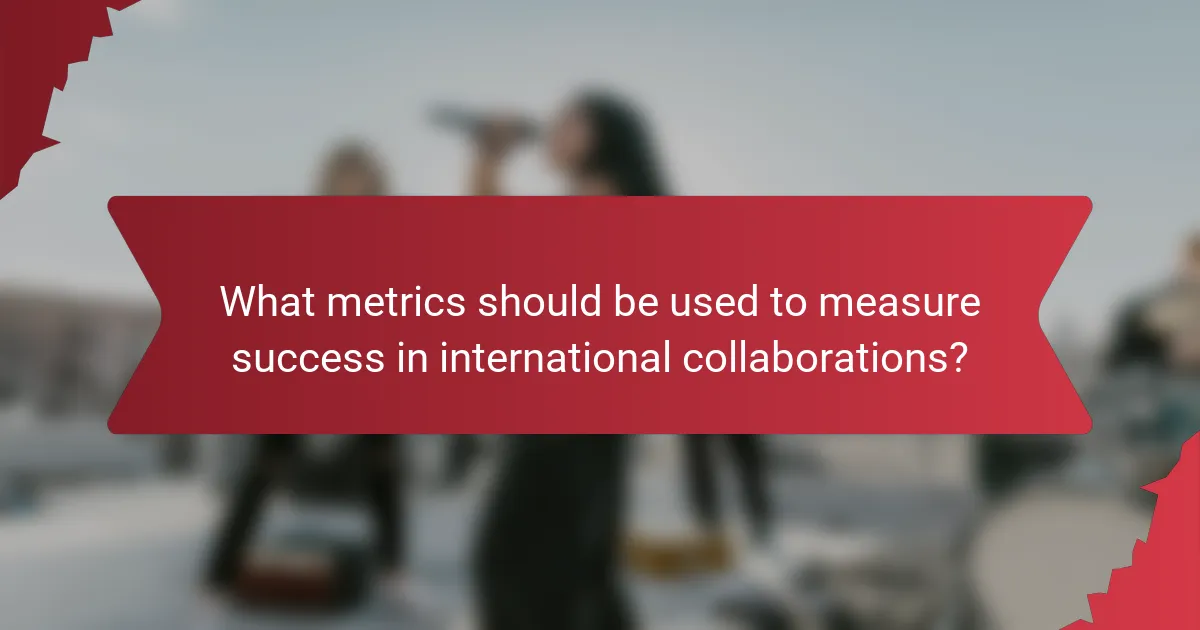
What metrics should be used to measure success in international collaborations?
To measure success in international collaborations, focus on metrics like audience reach, engagement rates, and collaboration growth. These metrics reveal the effectiveness of marketing approaches and promotion techniques.
| Metric | Description | Value |
|———————-|————————————————–|—————————-|
| Audience Reach | Total listeners across platforms | Global streaming numbers |
| Engagement Rate | Interaction levels (likes, shares, comments) | Percentage of total views |
| Collaboration Growth | Number of new partnerships formed | Year-over-year increase |
| Brand Awareness | Recognition in target markets | Survey results |
| Revenue Impact | Financial growth from collaborations | Increased sales figures |
| Social Media Impact | Follower growth on social platforms | Percentage growth |
How can engagement rates inform future marketing strategies?
Engagement rates can guide future marketing strategies by revealing audience preferences and content effectiveness. Analyzing these rates helps identify successful promotional techniques and informs decisions on collaboration partners. For instance, higher engagement may indicate a strong resonance with specific demographics. This insight enables targeted marketing efforts that enhance global reach in international indie music collaborations.
What role does audience feedback play in refining approaches?
Audience feedback is crucial for refining marketing approaches in international indie music collaborations. It provides insights into listener preferences, helping artists and promoters tailor their strategies effectively. By analyzing feedback, teams can identify which promotional techniques resonate, enhancing global reach. This iterative process allows for adjustments based on unique audience reactions, ensuring that marketing efforts align with diverse cultural contexts. Engaging with feedback fosters a more authentic connection with fans, ultimately driving better outcomes in collaboration efforts.

Which case studies exemplify successful international indie music collaborations?
Successful international indie music collaborations often include case studies like the following:
1. **Bon Iver and Kanye West**: Their collaboration on the song “Lost in the World” showcased a blend of indie folk and hip-hop, reaching diverse audiences globally.
2. **The xx and Jamie xx**: Their partnership highlighted the merging of electronic and indie music, resulting in widespread acclaim and international tours.
3. **ODESZA and Sofía Valdes**: This collaboration combined electronic sounds with indie vocals, leading to significant streaming success and global recognition.
4. **Tame Impala and Travis Scott**: Their joint effort on “Butterfly Effect” demonstrated how indie rock can intersect with mainstream hip-hop, expanding their reach.
5. **Alt-J and Tinashe**: Their unique blend of indie pop and R&B created a fresh sound, garnering attention across various markets.
These examples illustrate effective marketing approaches and promotion techniques that enhance global reach in the indie music scene.
What lessons can be learned from notable projects in different regions?
Notable projects in international indie music collaborations illustrate effective marketing approaches and promotion techniques. Lessons include leveraging social media for global reach, fostering cross-cultural partnerships, and utilizing local influencers to enhance visibility. These strategies demonstrate the importance of adaptability in diverse markets. Successful examples highlight the value of engaging storytelling and authentic artist narratives to connect with audiences worldwide.
How have collaborations adapted to changing market dynamics?
International indie music collaborations have evolved to leverage digital platforms and social media for broader reach. Artists now utilize streaming services and online marketing strategies to adapt to changing consumer preferences.
Collaborations increasingly focus on cross-genre partnerships, enhancing appeal to diverse audiences. These innovative approaches foster unique sounds and attract listeners from various backgrounds.
Data shows that successful collaborations can boost streaming numbers by up to 50%, showcasing the effectiveness of strategic partnerships. As a result, indie artists gain global visibility and expand their fan base.
Emerging trends include virtual concerts and online festivals, which allow artists to connect with fans worldwide. This shift reflects the industry’s adaptability to market dynamics and consumer behavior changes.
What are common pitfalls in international music collaborations?
Common pitfalls in international music collaborations include cultural misunderstandings, lack of clear communication, and differing expectations. These issues can hinder creative synergy and project success.
Cultural misunderstandings often arise from varying artistic norms and practices across regions. For example, what is considered innovative in one culture may be seen as unconventional in another.
Lack of clear communication can lead to confusion regarding roles, responsibilities, and project timelines. Establishing consistent channels for dialogue is crucial for alignment.
Differing expectations about promotion and marketing strategies can result in ineffective outreach. Artists must agree on promotional tactics to maximize their global reach.
What best practices should artists follow to maximize impact?
Artists should focus on authentic storytelling, leveraging social media, and engaging with diverse audiences to maximize impact. Collaborating internationally enhances visibility and creates unique marketing opportunities. Consistency in branding and messaging strengthens recognition across global platforms. Utilizing analytics to track engagement informs future strategies for promotion and outreach.
